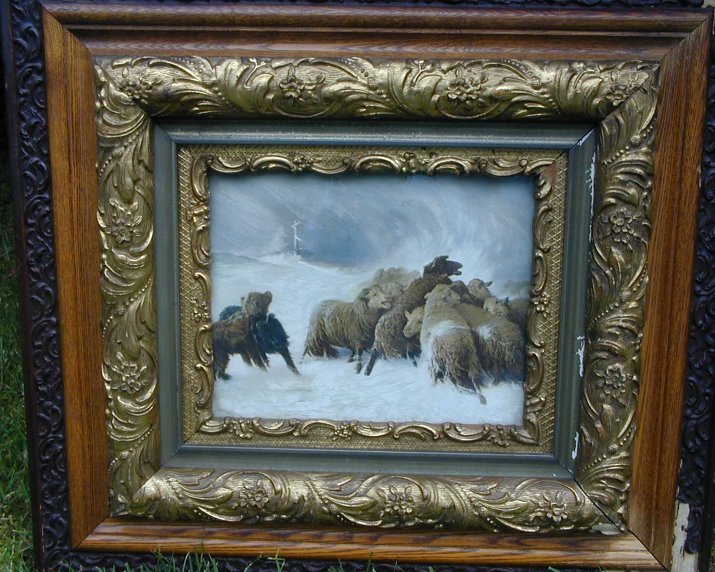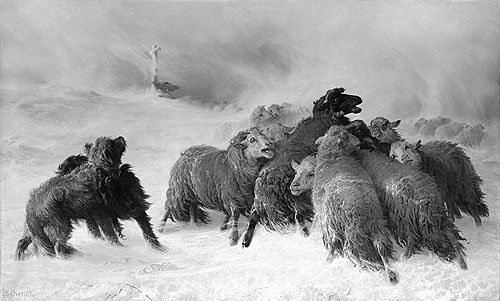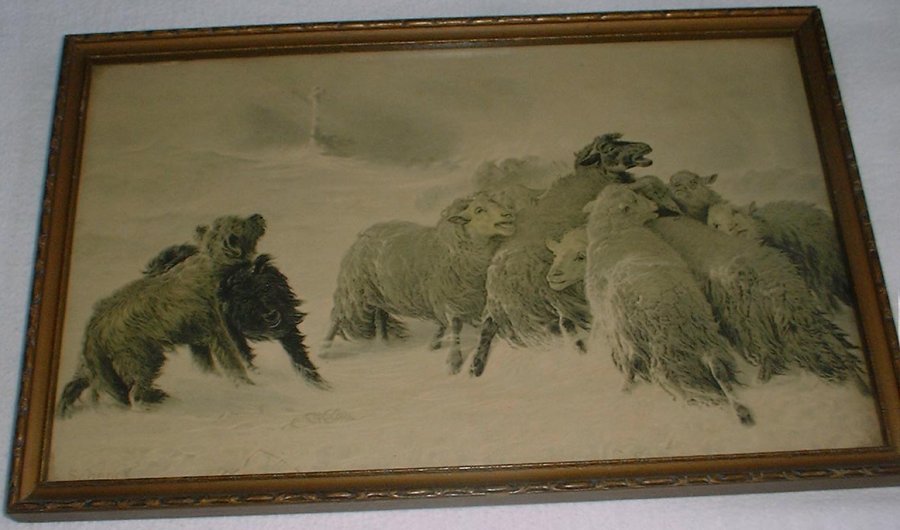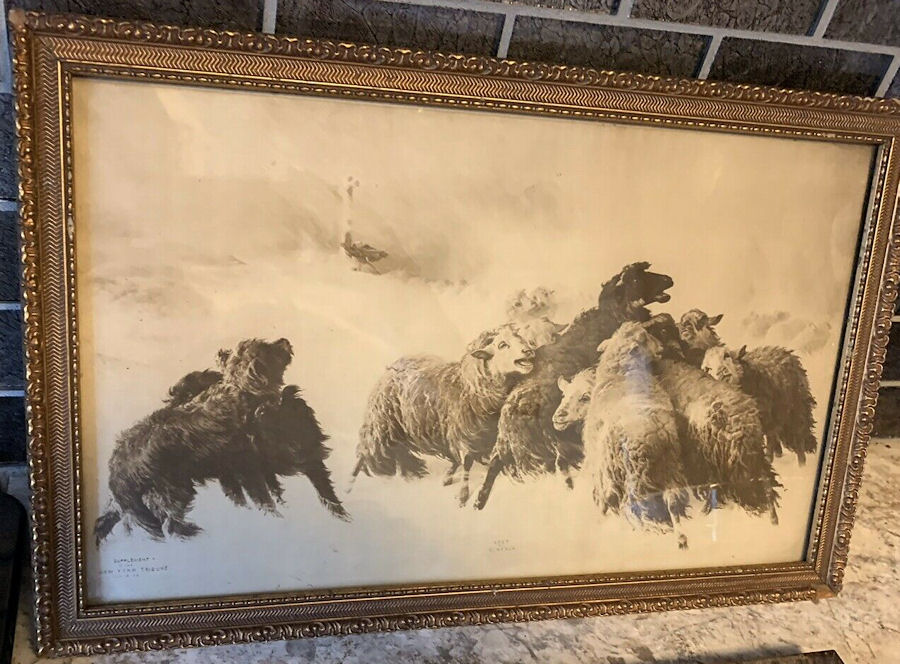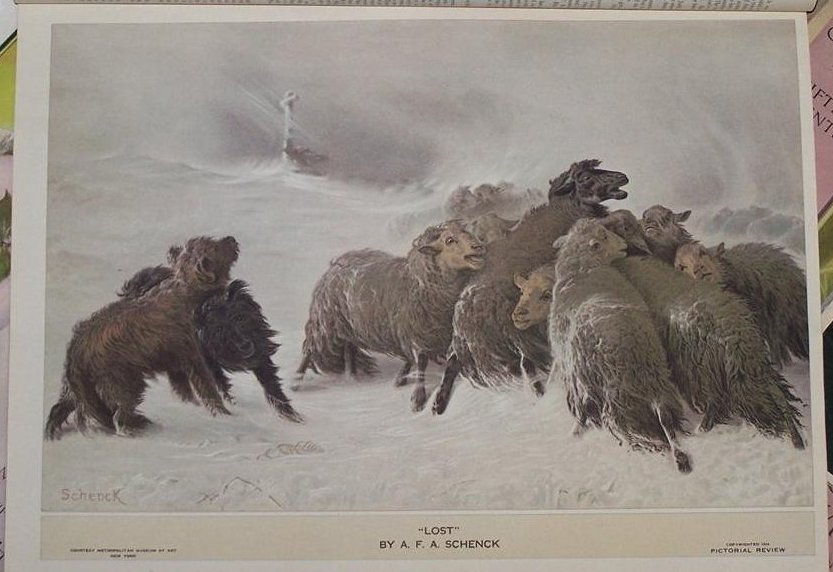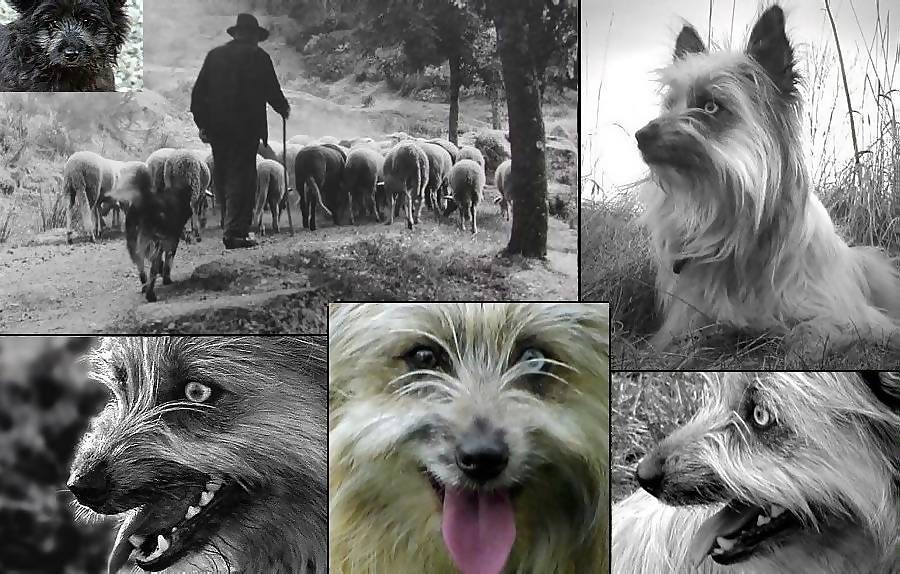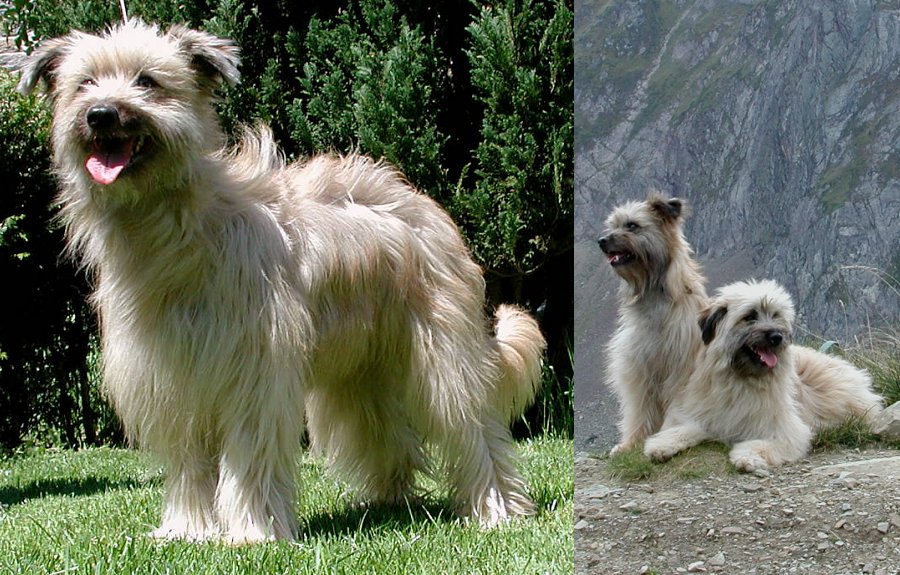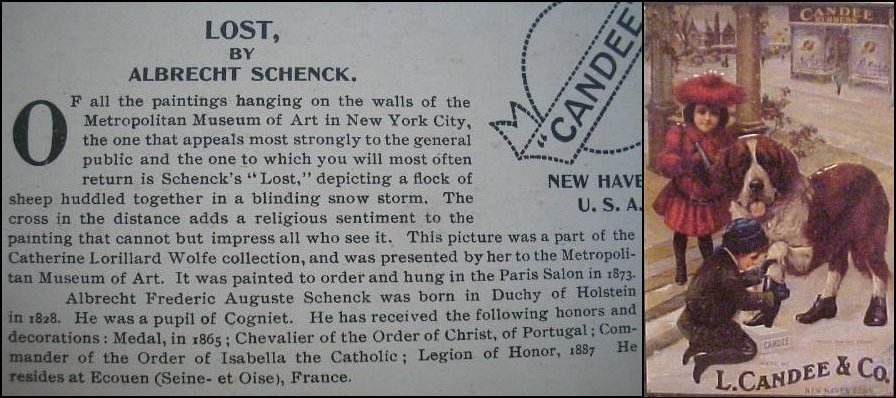ALBERT (OR ALBRECHT) SCHENCK (1828-1901)
- PAGE 06 -
LOST: SOUVENIR OF AUVERGNE (1873)
|
Albert Schenck Data Pages
01,
02
&
04
are now on site. Plus all
of the image pages, accessible though the index on page
05. To search for specific text on this page, just press 'CTRL + F' & then enter your search term. Here I present an image from a visitor to my site who bought an old home & found this Albert Schenck work in the attic. Entitled 'Lost in the Storm'. Is it not a lovely painting! And frame! I think that we now believe this in fact to be a chromolitho (a coloured lithograph) & not a painting. This litho must have been very popular indeed. It was painted, I believe in 1873. It was republished as an insert to the New York Tribune on Sunday, Apr. 18, 1909 and again by the Metropolitan Museum of Art in New York and by Pictorial Review Magazine, both in 1924. And who knows - maybe republished many other times too. I would still like to locate for this page a good image of the whole work, taken straight on & in good detail.
You
can see my source for
some of that data
here. At left, is
the image available from the Metropolitan Museum of Art site referred to above.
In black & white, but beautiful. I trust that the museum will not object to my showing the image here.
The work is, I see, not on public display as this page is updated in Sep. 2013.
It is available as a large black & white image at that Museum link. But I have difficulty in providing a link to the full screen version.
An image of another print of the work thanks to Jennifer Diaz. The print bears a discrete but distinctive image of a tiny flower at bottom left - but the significance of it is not known to the webmaster.
I referred above to the work having been published in the New York Tribune on Apl. 18, 1909. This site has existed for many years & in all those years I do not recall actually seeing an image of that print. Until Feb. 2020 that is, when such a print was offered for sale via e-Bay. A 'buy-it-now' item at U.S. $25.00. An image of the print & of the words at left & centre in the print are next.
I refer above to the work having been published in Pictorial Review Magazine in 1924. That data must be incorrect, because an issue of Pictorial Review Magazine (a womens magazine of 84 pages and 14 x 11 inches in size) was sold via e-Bay in Sep. 2006 - for U.S. $12.49. It was dated Jan. 1925 with a cover by 'Earl Christy'. A composite image of the work and of the interesting cover, appears next. Another copy of that very same issue was sold in Mar. 2007 for U.S. $39.77. Surely Pictorial Review Magazine would not reissue in 1925 what they published in 1924. A print, which was available in May 2007, is marked as being by 'The U.S. Printing and Lithograph Co. New York, N.Y. Facsimile No. 506.' No indication of dating, however.
And here, ex a long-expired e-Bay listing, is the 'Pictorial Review' page and 'Lost' image. This is the best image of the work that I have, so here is perhaps a good place to address a visitor's question - which she then answered for herself and for me! Whether there is a human figure in the work. It would seem that there is. The dark area at the base of the cross is, I understand, the shepherd 'clinging to the cross for support against the wind.'
There are many questions as to the breed of dog that is depicted in 'Found' on page 8 of this site. But until now, in Jul. 2005, no comments have been received about the dogs in the work above. But in a most interesting message, Sue Harpell, of Edgecomb, Maine, U.S.A., advises me as follows. Sue, we thank you!
I understand that that the 'Réunion des Amateurs de Chiens Pyrénéens'
or R.A.C.P. was established long ago, in 1901. It is affiliated with 'la Société Centrale Canine',
the highest authority respecting dogs in France. The French Ministry of
Agriculture granted it, in 1969, both the right and the responsibility to
administer the breed standard for Pyrenean dog breeds generally, including this
particular breed.
And a composite image of the breed with two images kindly provided by Christian Janes. To better show
the 'Berger des Pyrénées' 'rough faced' dog. Christian breeds the dogs
at his 'de la Vallée du Mouton' kennels
at Zieglstadl, in Austria. The image at right was taken in the French Pyrenees - how
appropriate.
It would seem that not everyone believes that the dog so often featured in Schenck's works is a 'Berger des Pyrenees'!
'Stephanie', from Texas, advises that she believes the dog to be a Belgian Sheepdog or 'Groenendael'. 'If you look
at the sheep, the black dog is putting itself between the danger, and the sheep,
something this dog does naturally. They are abundant in France and obviously in Belgium
also.' What is shown in the painting, Stephanie states, is a long haired male;
there is no mistaking that beautiful long haired silhouette, & face. E-Bay sure is an invaluable research tool! I learn that 'Lost' was featured in a series of Victorian Trade Cards published by the Candee Rubber Company (or perhaps L. Candee Rubber Company) of New Haven, Connecticut. That company was, I read, founded in 1843 and in 1844 was licensed by Charles Goodyear to make vulcanized rubber overshoes after Goodyear obtained a patent for his rubber vulcanizing process. Candee produced advertising throughout for the 50 years it was in business - until 1892 when it merged with or became U.S. Rubber Co. (not sure which). These particular trade cards were a series of ten of the world's most famous paintings with descriptions of the works and Candee's advertising on the reverse - and produced in two sizes of 6 x 8 inches and 5 1/4 x 9 inches. The 'Lost' work is of the latter size and features the Candee 'Storm King' boot on the back. You could get a set of five cards at the time for 8 cents payable in stamps or coin to be sent to the Advertising Department of Candee at 15 Murray Street, in New York. The other nine works were: 'Reading from Homer' by Alma Tadema, 'The Ferryman' by Emile Bayard, 'Queen Louise' by Gustave Richter, 'The Storm' by Pierre Auguste Cot, 'The Dutchess of Devonshire' by Thomas Gainsborough RA, 'The Departure for Church' by Frederick Kaemmerer, 'The Horse Fair' by Rosa Bonheur, 'The Imperial Courier' by Adolph Schreyer and 'The Wedding Feast' by Konstantin Makovski. And here, without more ado, are two composite images. Firstly the Schenck Candee card, using images kindly provided by Samantha Prince of Central Pennsylvania. Thank you so very much, Samantha! And secondly, the enlarged words on the rear of the card which described the Schenck painting along with a charming but unrelated (to Schenck) L. Candee Rubber Company advertisement of the time.
Before moving on to other matters, I note that in May 2021,
a copy of the Candee Rubber 'Lost' card is available via e-Bay.
Offered at U.S. $18.24.
More about the above work when I have more to tell you! And if you have any more data on the subject, do please contact me. To the Schenck Data Pages
01,
02
&
04.
Page
05 is an
image index page.
|
